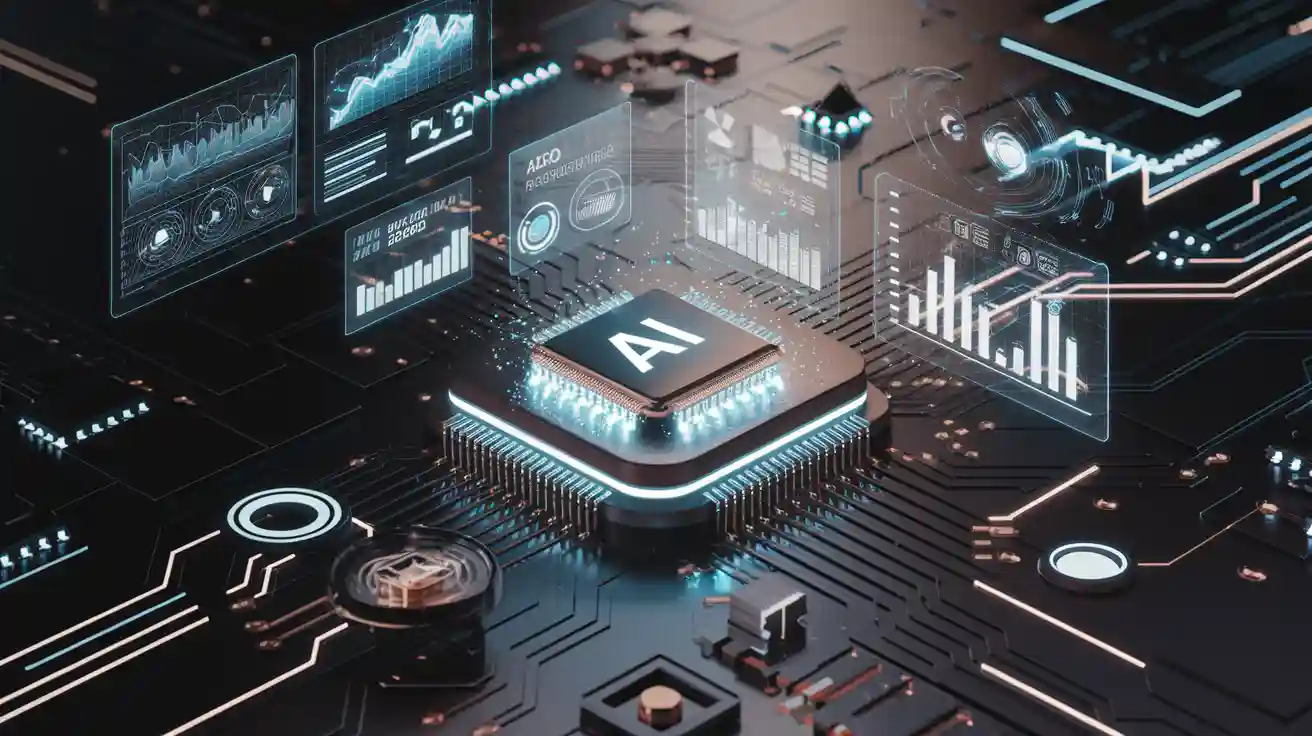
Artificial intelligence continues to redefine industries, unlocking unprecedented opportunities for growth. By 2030, its contributions will reshape economies worldwide:
-
AI is projected to drive a $15.7 trillion increase in the global economy.
-
North America's GDP could rise by 14.5%, while China may see a 26% boost through AI initiatives.
-
AI tool users are expected to grow sixfold, reaching over 729 million by 2030.
Understanding AI trends equips you to harness this transformative power, ensuring your business thrives in this evolving landscape.
Key Takeaways
-
AI will add $15.7 trillion to the world economy by 2030. This will give businesses many chances to grow and create new ideas.
-
Generative AI is changing industries by making content automatically. It also improves how customers feel about services, so businesses need to use it.
-
AI-as-a-Service (AIaaS) makes AI tools easy to use. It helps all businesses use AI without spending a lot of money at first.
Key AI Trends to Watch

Generative AI and its widespread adoption
Generative AI is transforming how businesses create, innovate, and collaborate. You can leverage this technology to automate content creation, streamline workflows, and enhance customer experiences. For example, generative AI tools like ChatGPT and DALL-E are enabling companies to produce high-quality text, images, and videos in record time.
Organizations are rapidly adopting generative AI across sectors. A recent study highlights:
-
100% of businesses are creating new KPIs to measure AI performance.
-
99% are actively stepping up AI adoption efforts.
-
80% of respondents believe generative AI is essential for collaboration.
-
76% feel it plays a critical role in improving customer experience.
Generative AI is also reshaping work dynamics. For 20% of workers, it accounts for 6% to 25% of their work hours, with common use cases including writing assistance, coding support, and customer service automation.
Multimodal AI for integrated data processing
Multimodal AI combines data from multiple sources, such as text, images, and audio, to deliver more accurate insights. This trend is revolutionizing industries by enabling integrated data processing. You can use multimodal AI to enhance product recommendations, optimize supply chains, and improve marketing campaigns.
|
Industry |
Impact Description |
Statistic |
|---|---|---|
|
Retail |
Enhances product recommendations and personalizes shopping |
|
|
Marketing and Advertising |
Improves click-through rates and reduces costs |
30% improvement in click-through rates, 20% reduction in advertising costs |
|
Supply Chain Optimization |
Provides insights into inventory and demand forecasting |
10% reduction in supply chain costs, 15% improvement in on-time delivery rates |
|
Finance |
Connects financial data for better decision-making |
5% improvement in investment returns, 20% reduction in fraud detection times |
|
Manufacturing |
Identifies defects through image analysis |
40% reduction in defect identification time |
Multimodal AI empowers businesses to make smarter decisions by connecting diverse data points, ultimately driving efficiency and profitability.
Ethical AI and responsible innovation
As AI becomes more pervasive, ethical considerations are gaining prominence. You must prioritize responsible innovation to build trust and ensure AI technologies benefit society. Ethical AI addresses concerns about safety, reliability, and community impact.
|
Aspect |
الوصف |
|---|---|
|
Safety |
Questions about the safety of AI technologies. |
|
Trust |
Concerns regarding the reliability of AI outputs. |
|
Community Impact |
Considerations on how AI affects individuals. |
Over 50 countries are implementing UNESCO's Recommendation on the Ethics of Artificial Intelligence. Prominent figures like Elon Musk, Stuart Russell, and Sam Altman advocate for ethical AI practices. By adopting transparent and fair AI systems, you can align with global standards and foster trust among stakeholders.
Edge AI for real-time decision-making
Edge AI processes data locally, enabling real-time decision-making without relying on cloud computing. This trend is crucial for industries requiring immediate insights, such as healthcare, manufacturing, and transportation.
Real-time analytics provided by edge AI allows leadership teams to access up-to-the-minute insights. You can use this capability to pivot strategies instantly and forecast customer demand accurately. Edge AI also reduces uncertainties by analyzing historical data alongside real-time inputs, helping businesses seize growth opportunities.
Artificial emotional intelligence for personalized interactions
Artificial emotional intelligence (Emotion AI) is enhancing personalized interactions by analyzing emotional cues. You can use this technology to improve customer service, marketing campaigns, and healthcare outcomes.
|
Application Area |
Benefits of Emotion AI |
|---|---|
|
Customer Service |
Improved empathetic responses leading to better interactions |
|
Marketing |
Enhanced campaign effectiveness through emotional targeting |
|
E-commerce |
Personalized product recommendations based on emotional state |
|
Healthcare |
Individualized patient care based on emotional assessments |
Emotion AI increases engagement, boosts customer satisfaction, and improves conversion rates. By tailoring interactions to emotional states, businesses can foster deeper connections with their audiences.
AI-as-a-Service (AIaaS) and its growing accessibility
AI-as-a-Service (AIaaS) is democratizing access to AI technologies, allowing businesses of all sizes to integrate AI into their operations. You can leverage AIaaS platforms to access machine learning models, natural language processing tools, and predictive analytics without significant upfront investments.
|
Year |
Market Size (USD) |
CAGR (%) |
|---|---|---|
|
2024 |
24.947 billion |
46.52 |
|
2029 |
168.449 billion |
|
|
2033 |
269.4 billion |
33.2 |
|
2032 |
626.64 billion |
39.3 |
|
2030 |
397.81 billion |
30.9 |
AIaaS is projected to grow exponentially, with Machine Learning as a Service (MLaaS) expected to hit $626.64 billion by 2032. This accessibility allows businesses to scale AI adoption quickly and efficiently, unlocking new opportunities for innovation.
Industry-Specific Applications of AI

Retail: Enhancing personalization and supply chain efficiency
AI is transforming retail by improving personalization and optimizing supply chains. You can use AI to analyze customer preferences and deliver tailored shopping experiences. Retailers report significant benefits:
|
Statistic |
Percentage |
|---|---|
|
Retailers acknowledging AI enhances customer experience |
|
|
Retailers reporting AI's role in supply chain optimization |
76% |
|
Retailers implementing AI or automation |
86% |
|
Retailers experiencing cost savings from AI |
49% |
|
Retailers reporting an increase in revenues |
43% |
|
Retailers witnessing improved productivity |
44% |
AI helps you reduce costs, boost productivity, and increase revenue. By adopting AI-driven tools, you can enhance customer engagement and streamline operations.
Healthcare: Revolutionizing diagnostics and patient care
AI is revolutionizing healthcare by improving diagnostic accuracy and patient outcomes. Early disease detection powered by AI leads to higher survival rates. For example:
|
Disease Type |
Survival Rate (Early Diagnosis) |
Survival Rate (Late Diagnosis) |
|---|---|---|
|
Breast Cancer |
N/A |
|
|
Colorectal Cancer |
Around 90% |
14% |
AI enables earlier interventions, which improve survival rates and reduce treatment costs. You can leverage AI to enhance patient care and streamline medical processes.
Financial services: Strengthening fraud detection and analytics
AI is a game-changer in financial services, helping you detect fraud and improve analytics. Major banks report significant reductions in fraud losses and increased customer trust. Key metrics include:
|
Metric Description |
1TP15التالي |
|---|---|
|
Uplift in detecting money mule activity |
|
|
Detection of potential fraud losses in e-commerce |
95% |
|
Uplift in identifying bonus abuse in gaming |
98% |
|
Customer recognition rate at login |
99% |
AI improves fraud detection accuracy and strengthens customer security. You can use AI to safeguard your financial operations and build trust with clients.
Manufacturing: Driving automation and predictive maintenance
AI drives automation and predictive maintenance in manufacturing, reducing costs and improving efficiency. You can use AI to extend equipment lifespan and minimize downtime.
|
Improvement Area |
Impact |
|---|---|
|
Equipment Lifespan |
Increased by up to 20% |
|
Unscheduled Downtime |
Reduced by up to 35% |
|
Maintenance Costs |
Decreased by up to 25% |
AI-powered systems help you optimize production processes and reduce energy consumption. By adopting AI, you can achieve higher operational efficiency and cost savings.
Transportation: Advancing autonomous vehicles and logistics
AI is advancing transportation through autonomous vehicles and intelligent logistics. Autonomous systems optimize routes, reduce traffic congestion, and maximize vehicle utilization. Benefits include:
-
Continuous operation for higher productivity.
-
Cost savings from reduced labor and fuel consumption.
-
Enhanced safety and user experiences.
The AI in Transportation market is projected to reach USD 21.4 billion by 2033, with a CAGR of 19.5%. You can use AI to improve logistics, reduce costs, and enhance transportation efficiency.
Business Opportunities from AI
Boosting productivity and operational efficiency
AI is revolutionizing how businesses operate by streamlining processes and enhancing productivity. You can leverage AI to automate repetitive tasks, allowing your team to focus on strategic initiatives. For instance, JPMorgan Chase's NLP system, COiN, reviews loan agreements in seconds, saving 360,000 hours annually. Similarly, Netflix uses machine learning to personalize content recommendations, saving $1 billion annually in customer retention.
Across industries, AI adoption is driving significant growth:
|
Industry |
AI Impact Description |
Projected Growth/Statistics |
|---|---|---|
|
Healthcare |
AI aids in diagnostics, data management, and personalized medicine. |
Valuation to reach $20.65 billion in 2023 and $187.95 billion by 2030. |
|
Automotive |
Machine learning applications improved vehicle safety and performance. |
Applications grew by 48%. |
|
General |
Staff utilizing AI can experience up to an 80% improvement in productivity. |
Global AI adoption at 72% by 2024. |
By integrating AI into your operations, you can achieve faster decision-making, reduce errors, and unlock new levels of efficiency.
Reducing costs through automation
AI-powered automation is helping businesses cut costs while maintaining high-quality outputs. You can use AI to optimize workflows, reduce labor expenses, and minimize resource wastage. For example, Amazon Go stores utilize computer vision for a checkout-free experience, significantly reducing operational costs. Telefónica O2, a telecommunications company, handles 400,000 to 500,000 transactions monthly with robotic process automation (RPA), achieving a 650% ROI over three years.
Cost-saving statistics further highlight AI's impact:
-
4% of companies saw cost savings of at least 20% after adopting AI.
-
28% of companies lowered their costs by 10% or less.
-
One-tenth of enterprises experienced cost reductions of 10 to 19%.
Organizations that have advanced beyond initial AI testing report an average cost savings of 32%, according to Deloitte. Early adopters across industries also report tangible financial benefits, with 82% experiencing measurable savings.
By automating routine tasks, you can reduce operational costs and allocate resources more effectively.
Driving sustainability and green initiatives
AI is playing a pivotal role in promoting sustainability and driving green business practices. You can use AI to optimize energy consumption, reduce waste, and enhance supply chain transparency. For example, the Corporate Sustainability Reporting Directive (CSRD) establishes ESG reporting requirements, ensuring organizations maintain transparency in their sustainability efforts.
The EU AI Act also mandates that AI-based software must be environmentally friendly, encouraging companies to consider the environmental impact of their AI practices. These regulations aim to foster green initiatives and align businesses with global sustainability goals.
By adopting AI-driven solutions, you can reduce your carbon footprint and contribute to a more sustainable future.
Enhancing customer experience and engagement
AI is transforming customer interactions by delivering personalized, seamless experiences. You can use AI chatbots to provide instant assistance, anticipate customer needs, and tailor interactions based on individual preferences. For example, AI applications significantly improve customer satisfaction by enhancing Net Promoter Scores (NPS) and reducing churn rates.
Key metrics that highlight AI's impact on customer engagement include:
-
Net Promoter Score (NPS): Measures customer loyalty and willingness to recommend your brand.
-
Customer Lifetime Value (CLV): Represents total revenues generated from a client throughout the relationship.
-
Churn Rate: Reflects the percentage of clients who stop using your products or services.
AI also enables proactive engagement, encouraging purchases before cart abandonment. By leveraging these capabilities, you can build stronger relationships with your customers and boost overall satisfaction.
Unlocking new revenue streams and business models
AI innovations are opening doors to new revenue opportunities and business models. You can use AI to develop personalized products, optimize pricing strategies, and expand into untapped markets. For example, Pentagon Federal Credit Union achieved a 20% increase in loan applications and a 30% improvement in customer satisfaction through AI-driven personalization.
Other success stories include:
-
Brinks Home increased its average direct-to-consumer package size from $489 to $968, resulting in a 9.5% overall revenue growth.
-
A 2024 study found that AI investment correlates with approximately 20% higher sales and a 22% increase in market valuation, driven by new product offerings and market expansion.
By embracing AI, you can unlock innovative business models and position your company for long-term growth.
Challenges and Considerations
Addressing ethical concerns and biases
Ethical concerns and biases in AI systems present significant challenges. Algorithmic bias can lead to unfair outcomes, such as discrimination in hiring practices or misrepresentation in facial recognition tools. Privacy risks also arise when personal data is collected and used without robust safeguards. A lack of accountability in AI decision-making can further erode trust.
|
Example |
الوصف |
|---|---|
|
A major company discontinued its AI hiring tool due to bias against women. |
|
|
Facial Recognition Tool |
A tech firm abandoned its tool after it showed bias against certain groups. |
|
Image-Cropping Algorithm |
A platform apologized for favoring White faces over others in images. |
Implementing ethical AI requires balancing transparency with proprietary concerns. You must also navigate diverse regulatory frameworks, which can be both costly and time-consuming. By prioritizing fairness and accountability, you can build trust and ensure your AI systems benefit society.
Adapting to stricter regulatory environments
The regulatory landscape for AI is evolving rapidly. Laws like the EU AI Act categorize AI systems by risk and impose strict requirements on high-risk applications. The NIST AI Risk Management Framework provides guidelines for managing AI risks throughout their lifecycle. These frameworks aim to mitigate risks but also create compliance challenges.
-
AI impact assessments are now essential for responsible AI deployment.
-
Organizations must align with diverse regulations, including sector-specific guidelines.
-
Robust assessments are necessary to address ethical implications and legal compliance.
|
Regulation |
Key Features |
Purpose |
|---|---|---|
|
EU AI Act |
Categorizes AI by risk, mandates compliance for high-risk systems |
Ensures ethical AI development and safety |
|
GDPR |
Data portability, breach notifications, right to be forgotten |
Protects personal data and user rights |
|
CCPA |
Right to know, delete, or opt-out of data collection |
Enhances consumer privacy and control |
Navigating these complexities requires proactive planning and investment in compliance measures.
Reskilling the workforce for AI-driven roles
AI adoption is reshaping the workforce, creating a pressing need for reskilling. By 2025, 50% of employees will require new skills due to automation. High-performing AI companies expect over 30% of their workforce to undergo reskilling.
|
Source |
Statistic |
الوصف |
|---|---|---|
|
McKinsey |
20% |
Organizations expect 20% of employees to need reskilling. |
|
WEF |
50% |
Half of all employees will need reskilling by 2025. |
|
Coursera |
866% |
Demand for generative AI skills has surged by 866%. |
You can address this challenge by investing in training programs and fostering a culture of continuous learning. This ensures your workforce remains competitive in an AI-driven economy.
Balancing innovation with data privacy and security
Rapid AI innovation often conflicts with the need for robust data privacy and security measures. Regulations like GDPR and CCPA emphasize user rights, including data portability and the right to be forgotten. The EU AI Act further mandates compliance for high-risk AI applications.
|
Regulation |
Key Features |
Purpose |
|---|---|---|
|
GDPR |
Mandatory breach notifications, right to data deletion |
Protects personal data and ensures user rights |
|
CCPA |
Opt-out of data sale, request data deletion |
Enhances consumer privacy and control |
|
EU AI Act |
Risk-based categorization, compliance for high-risk AI |
Promotes ethical AI development |
To balance innovation with privacy, you must adopt secure data practices and ensure transparency in AI operations. This approach builds trust while fostering sustainable growth.
Practical Steps for Businesses
Start with pilot projects and scale gradually
Starting small with AI pilot projects allows you to test the waters before committing to full-scale implementation. Focus on measurable outcomes to evaluate success. For example, track business KPIs like churn rate and customer lifetime value. Operational metrics, such as the percentage of decisions automated by AI, also provide valuable insights.
|
الفئة |
Examples |
|---|---|
|
Business KPIs |
Churn rate, customer lifetime value, NPS |
|
Operational Metrics |
Percentage of decisions automated by AI, average handling time reduction |
|
User-Centric Metrics |
Adoption rates, user satisfaction, survey responses on confidence in the AI tool |
|
ROI and Financial Metrics |
Costs of running AI vs. quantified benefits (increased revenue, savings) |
|
Technical Performance Metrics |
Frequency of AI output usage vs. overrides, bias checks on model outputs |
Gradually scaling successful pilots ensures you minimize risks while maximizing returns. Regular reviews against these metrics help you refine your approach.
Leverage AI tools and platforms tailored to needs
Choosing the right AI tools is critical for achieving your goals. Evaluate platforms based on compatibility, scalability, and integration capabilities. For example:
|
Platform Name |
Key Features |
Target Audience |
|---|---|---|
|
Platform 1 |
Real-time monitoring, analytics, AI trend identification |
Managers seeking performance tracking |
|
Platform 2 |
Tailored feedback, interactive interface |
Customer service representatives |
|
Platform 3 |
User-friendly dashboard, comprehensive evaluations |
Marketing and operational teams |
|
Platform 4 |
Integration with CRM systems |
Organizations needing data visibility |
Assessing data security and privacy measures is equally important. By aligning tools with your specific needs, you can unlock their full potential.
Foster a culture of innovation and learning
AI adoption thrives in an environment that encourages experimentation and continuous learning. Invest in training programs to upskill your workforce. Highlight the importance of staying updated on AI trends and technologies. Encourage employees to share insights and collaborate on innovative solutions. This approach fosters adaptability and ensures your team remains competitive.
Collaborate with AI experts and partners
Partnering with AI experts accelerates your journey toward successful implementation. For instance, the Gloucestershire Hospitals NHS Foundation Trust used AI to improve patient outcomes and operational efficiency. Collaborations like these bring specialized knowledge and resources to your projects. They also enhance communication and streamline processes, ensuring better results.
Prioritize ethical AI practices and transparency
Ethical AI practices build trust and ensure long-term success. Focus on fairness, transparency, and accountability. Regular audits can identify biases or errors in your systems. Engage stakeholders in the governance process to enhance trust and accountability.
|
Key Practice |
الوصف |
|---|---|
|
Fairness Measures |
Systematic actions to address and mitigate biases in AI systems, ensuring balanced outcomes. |
|
Transparency and Accountability |
Clear documentation of decision-making processes to allow stakeholder understanding. |
|
Regular Audits and Oversight |
Conducting audits to identify biases, errors, or compliance issues in AI systems. |
|
Stakeholder Engagement |
Involving stakeholders in the AI governance process to enhance accountability and trust. |
By prioritizing these measures, you can align your AI initiatives with ethical standards and societal expectations.
The transformative potential of AI trends from 2025 to 2030 is undeniable. Businesses must act now to adapt and innovate. Generative AI alone could boost the global economy by nearly $7 trillion by 2030. Additionally, AI will reshape workforce dynamics and cybersecurity strategies, as shown below:
|
Trend/Forecast |
الوصف |
|---|---|
|
Job Market Disruption |
23% of organizations expect job losses due to AI, while 49% anticipate new roles being created. |
|
Rise of AI Agents |
By 2028, 15% of routine work decisions are predicted to be made autonomously by AI agents. |
|
Importance in Cybersecurity |
AI will be crucial in combating increasing cyber threats, requiring businesses to integrate AI solutions. |
-
Generative AI could increase global labor productivity by 1.4% annually.
-
U.S. productivity is expected to rise by 1.5% each year due to AI advancements.
Position your business for success by embracing AI today. Proactive adaptation ensures you stay competitive in this rapidly evolving landscape.
التعليمات
What industries benefit the most from AI adoption?
AI impacts industries like healthcare, retail, finance, manufacturing, and transportation. You can use it to improve efficiency, reduce costs, and enhance customer experiences.
How can small businesses afford AI technologies?
AI-as-a-Service (AIaaS) platforms make AI accessible. These tools allow you to integrate AI without large upfront investments, enabling small businesses to compete effectively.
💡 Tip: Start with free or low-cost AI tools to test their impact before scaling up.
What skills should employees develop for an AI-driven future?
Focus on analytical thinking, data literacy, and AI tool proficiency. Upskilling in these areas ensures you stay competitive in an evolving job market.





